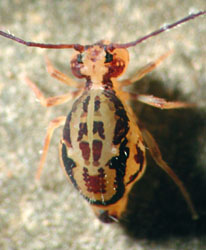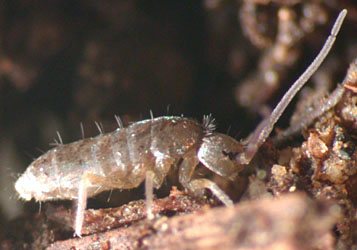Collembola
Springtails
David R. Maddison


This tree diagram shows the relationships between several groups of organisms.
The root of the current tree connects the organisms featured in this tree to their containing group and the rest of the Tree of Life. The basal branching point in the tree represents the ancestor of the other groups in the tree. This ancestor diversified over time into several descendent subgroups, which are represented as internal nodes and terminal taxa to the right.

You can click on the root to travel down the Tree of Life all the way to the root of all Life, and you can click on the names of descendent subgroups to travel up the Tree of Life all the way to individual species.
For more information on ToL tree formatting, please see Interpreting the Tree or Classification. To learn more about phylogenetic trees, please visit our Phylogenetic Biology pages.
close boxIntroduction
Springtails have the widest distribution of any hexapod group, occuring throughout the world, including Antarctica. They are probably the most abundant hexapods on Earth, with up to 250,000,000 individuals per square acre. They are found in soil, leaf litter, logs, dung, cave, shorelines, etc. There are about 6000 known species.
Devonian-Recent. Oldest fossil is of Rhyniella praecursor Hirst and Maulik from the Middle Devonian of Scotland.
The name "Collembola" is derived from "Colle" = glue and "embolon" = piston or peg. This refers to the belief that the ventral tube has adhesive properties, that is, that it is a "glue-peg". However, the tube's function is primarily for excretion and maintaining water balance.
Characteristics
Among the prominent derived characteristics of this group are:
- ventral tube ("collophore") on segment 1 of abdomen (adhesive in some groups, but primarily involved with excretion and water transport)
- springing mechanism formed from retinaculum on segment 3, furcula on segment 4
- 4-segmented antennae (segments sometimes subsegmented, giving the appearance of more than 4 segments)
- 6 abdominal segments
Other characteristics include:
- indirect sperm transfer with globular stalked spermatophore
- Some Neanuridae have polytene chromosomes
- Adults continue moulting throughout life (up to 50 moults)
- Reproductive instars alternate with feeding instars
- Cerci lacking
References
Betsch, J. M., J. M. Thibaud, and J. Najt. 1990. Recent progress in the taxonomy of Collembola (Insecta), especially by analysis of morphological homologies. Bull. Soc. Zool. Fr. 115:165-180.
Cassagnau, P. 1990. Des Hexapodes vieux de 400 millions d’années: les Collemboles. I. Biologie et évolution. L'Année biologique 29:1–37.
Christiansen, K. and P. Bellinger. 1995. The biogeography of Collembola. Polskie Pismo Entomologiczne 64:279-294.
Christiansen, K. and E. Pike. 2002. Cretaceous Collembola (Arthropoda, Hexapoda) from the Upper Cretaceous of Canada. Cretaceous Research 23:165-188.
Christiansen, K. and E. Pike. 2002. A preliminary report on the Cretaceous Collembola. Pedobiologia 46:267-273.
Deharveng, L., 2004. Recent advances in Collembola systematics. Pedobiologia 48:415–433.
D'Haese, C. 2002. Were the first springtails semi-aquatic? A phylogenetic approach by means of 28S rDNA and optimization alignment. Proceedings of the Royal Society of London B 269:1143-1151.
D'Haese, C. 2003. Morphological appraisal of Collembola phylogeny with special emphasis on Poduromorpha and a test of the aquatic origin hypothesis. Zoologica Scripta 32:563–586.
Frati, F., C. Simon, J. Sullivan, and D. L. Swofford. 1997. Evolution of the mitochondrial Cytochrome Oxidase II gene in Collembola. Journal of Molecular Evolution 44:145-158.
Greenslade, P. J. 1991. Collembola (Springtails). Pages 252-263 in Insects of Australia: A Textbook for Students and Research Workers. Volume I. Second Edition. I. D. Naumann, P. B. Carne, J. F. Lawrence, E. S. Nielsen, J. P. Spradberry, R. W. Taylor, M. J. Whitten and M. J. Littlejohn eds. Carlton, Victoria, Melbourne University Press.
Greenslade, P. J. and P. E. S. Whalley. 1986. The systematic position of Rhyniella praecursor Hirst & Maulik (Collembola), the earliest known hexapod. Pages 319-323 in Proceedings of the 2nd International Seminar on Apterygota. R. Dallai, ed. University of Siena.
Hopkin, S. P. 1997. Biology of the Springtails (Insecta: Collembola). Oxford University Press. 330 pp.
Lawrence, P. N. 1999. From whence and whither the Collembola? Crustaceana 72(9):1110-1122.
Lee, B.-H., U.-W. Hwang, W. Kim, K.-H. Park, and J.-T. Kim. 1995. Phylogenetic study of the suborder Arthropleona (Insecta: Collembola) based on morphological characters and 18S rDNA sequence analysis. Polskie Pismo Entomologiczne 64:261–277.
Mari Mutt, J. A. and P. F. Bellinger. 1990. A catalog of the Neotropical Collembola, including Nearctic areas of Mexico. Sandhill Crane Press, Gainesville, Florida.
Park, K. H. 2002. Phylogenetic analysis of Collembola based on highly variable region of 28S rRNA gene sequence. Korean Journal of Genetics 24(1):21-29.
Rusek, J. 1998. Biodiversity of Collembola and their functional role in the ecosystem. Biodiversity and Conservation 7:1207-1219.
Scott, H. G. 1961. Collembola: pictorial keys to the nearctic genera. Annals of the Entomological Society of America 54:104-113.
Thibaud, J.-M. and J. Najt. 1992. Isotogastruridae, a new family of terrestrial intrerstitial Collembola from the Lesser Antilles. Bonner zoologische Beitr?ge 4:545-551.
Whalley, P. and E. A. Jarzembowski. 1981. A new assessment of Rhyniella, the earliest insect, from the evonian of Rhynie, Scotland. Nature 291:317.
Xiong, Y., Y. Gao, W. Yin, and Y. Luan. 2008. Molecular phylogeny of Collembola inferred from ribosomal RNA genes. Molecular Phylogenetics and Evolution 49(3):728-735.
Information on the Internet
- Collembola of the World.
- Steve Hopkin Home Page. Provides great pictures of Collembola and a number of Collembola resources including a list of literature on Collembola published since 1995.
- The Springtails (Collembola) of South Africa. Penelope Greenslade, Australian National University.
- Check-list of the Springtails (Collembola) of Puerto Rico. Jos? A. Mari Mutt.
- Collembola Home Page. Part of the Pictographic Key to Leaf Litter Arthropods from the Missouri Ozark Forest Ecosystem Project (MOFEP).
- PMS Springtail Study Group. Postal Microscopical Society.
- Collembola of the Netherlands.
- Steve Hopkin's "The Biology of the Collembola (Springtails): The Most Abundant Insects in the World".
- Provisional Atlas of the Collembola of Britain and Ireland.
Title Illustrations

| Scientific Name | Collembola |
|---|---|
| Location | USA: Arizona: Tucson |
| Specimen Condition | Live Specimen |
| Image Use |
 This media file is licensed under the Creative Commons Attribution License - Version 3.0. This media file is licensed under the Creative Commons Attribution License - Version 3.0.
|
| Copyright |
© 2004 David R. Maddison

|
| Scientific Name | Symphypleona |
|---|---|
| Location | USA: California: Cold Creek |
| Specimen Condition | Live Specimen |
| Image Use |
 This media file is licensed under the Creative Commons Attribution License - Version 3.0. This media file is licensed under the Creative Commons Attribution License - Version 3.0.
|
| Copyright |
© 2004 David R. Maddison

|
| Scientific Name | Collembola |
|---|---|
| Location | USA: Arizona: Iron Springs |
| Specimen Condition | Live Specimen |
| Image Use |
 This media file is licensed under the Creative Commons Attribution License - Version 3.0. This media file is licensed under the Creative Commons Attribution License - Version 3.0.
|
| Copyright |
© 2004 David R. Maddison

|
About This Page
David R. Maddison

Oregon State University
Correspondence regarding this page should be directed to David R. Maddison at
david.maddison@science.oregonstate.edu
Page copyright © 2002 David R. Maddison
 Page: Tree of Life
Collembola. Springtails.
Authored by
David R. Maddison.
The TEXT of this page is licensed under the
Creative Commons Attribution License - Version 3.0. Note that images and other media
featured on this page are each governed by their own license, and they may or may not be available
for reuse. Click on an image or a media link to access the media data window, which provides the
relevant licensing information. For the general terms and conditions of ToL material reuse and
redistribution, please see the Tree of Life Copyright
Policies.
Page: Tree of Life
Collembola. Springtails.
Authored by
David R. Maddison.
The TEXT of this page is licensed under the
Creative Commons Attribution License - Version 3.0. Note that images and other media
featured on this page are each governed by their own license, and they may or may not be available
for reuse. Click on an image or a media link to access the media data window, which provides the
relevant licensing information. For the general terms and conditions of ToL material reuse and
redistribution, please see the Tree of Life Copyright
Policies.
Citing this page:
Maddison, David R. 2002. Collembola. Springtails. Version 01 January 2002 (under construction). http://tolweb.org/Collembola/8202/2002.01.01 in The Tree of Life Web Project, http://tolweb.org/











 Go to quick links
Go to quick search
Go to navigation for this section of the ToL site
Go to detailed links for the ToL site
Go to quick links
Go to quick search
Go to navigation for this section of the ToL site
Go to detailed links for the ToL site